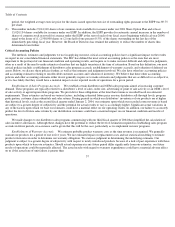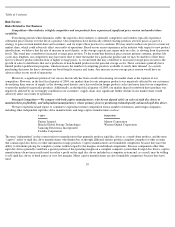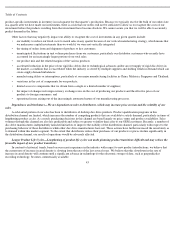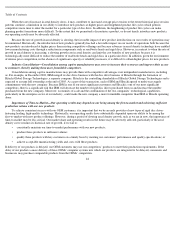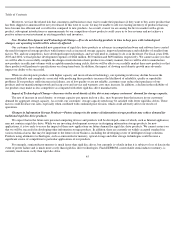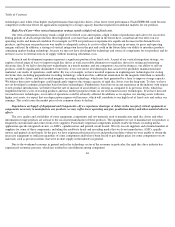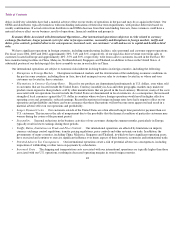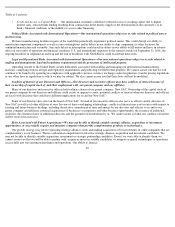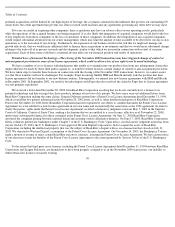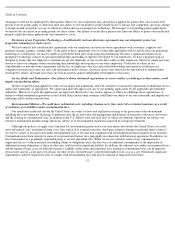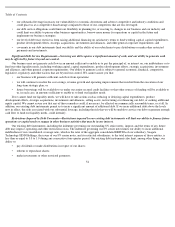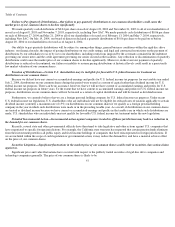Seagate 2003 Annual Report Download - page 48
Download and view the complete annual report
Please find page 48 of the 2003 Seagate annual report below. You can navigate through the pages in the report by either clicking on the pages listed below, or by using the keyword search tool below to find specific information within the annual report.
Table of Contents
manufacturers and may result in some component manufacturers exiting the industry or not making sufficient investments in research to
develop new components. In addition, the recent increases in demand for our mobile computing products, such as notebook computers, could
lead to shortages in the components used in smaller form factor rigid disc drives such as the glass substrates used to make the recording media
for such drives. These events could affect our ability to obtain critical components for our products, including our recently introduced line of
products for notebook computers, which in turn could have a material adverse effect on our prospects and results of operations.
If there is a shortage of, or delay in supplying us with, critical components, then:
•
it is likely that our suppliers would raise their prices and, if we could not pass these price increases to our customers, our operating
margin would decline;
•
we might have to reengineer some products, which would likely cause production and shipment delays, make the reengineered
products more costly and provide us with a lower rate of return on these products;
•
we would likely have to allocate the components we receive to certain of our products and ship less of others, which could reduce our
revenues and could cause us to lose sales to customers who could purchase more of their required products from manufacturers that
either did not experience these shortages or delays or that made different allocations; and
•
we might be late in shipping products, causing potential customers to make purchases from our competitors and, thus, causing our
revenue and operating margin to decline.
We cannot assure you that we will be able to obtain critical components in a timely and economic manner, or at all.
Dependence on Key Customers—We may be adversely affected by the loss of, or reduced, delayed or cancelled purchases by, one or
more of our larger customers.
For fiscal years 2004, 2003 and 2002, our top 10 customers accounted for approximately 62%, 63% and 63%, respectively, of our rigid
disc drive revenue. Hewlett-Packard accounted for approximately 19% and 18% of our rigid disc drive revenue for fiscal years 2004 and 2003,
respectively. Sales to Hewlett-Packard and Compaq together accounted for approximately 20% of our rigid disc drive revenue in fiscal year
2002. If any of our key customers were to significantly reduce their purchases from us, our results of operations would be adversely affected.
While sales to major customers may vary from period to period, a major customer that permanently discontinues or significantly reduces its
relationship with us could be difficult to replace. In line with industry practice, new customers usually require that we pass a lengthy and
rigorous qualification process at the customer’s cost. Accordingly, it may be difficult for us to attract new major customers.
Customer Concentration—Consolidation among our customers could cause sales of our products to decline.
Mergers, acquisitions, consolidations or other significant transactions involving our customers generally entail risks to our business. For
example, IBM, which is one of our key customers, merged its disc drive business with the disc drive business of Hitachi through the formation
of a new company with which IBM has entered into a multi-year supply agreement. As a result, IBM may decrease its purchases from us in
favor of this new company. If a significant transaction involving any of our key customers results in the loss of or reduction in purchases by
these key customers, it could have a materially adverse effect on our business, results of operations, financial condition and prospects.
OEM Purchase Agreements—Our OEM customers are not obligated to purchase our products.
Typically, our OEM purchase agreements permit OEMs to cancel orders and reschedule delivery dates without significant penalties. In
the past, orders from many of our OEMs were cancelled and delivery schedules were delayed as a result of changes in the requirements of the
OEMs’ customers. These order cancellations and
47


